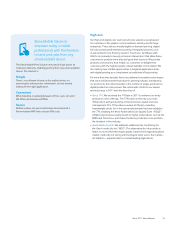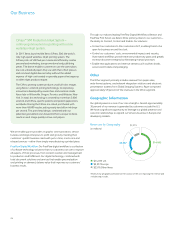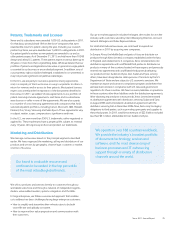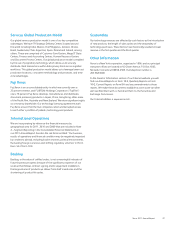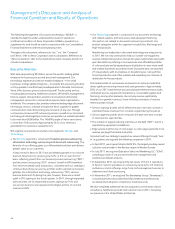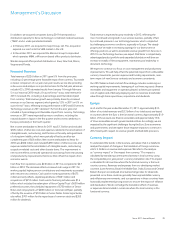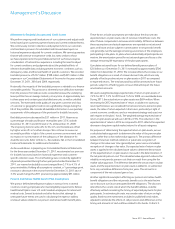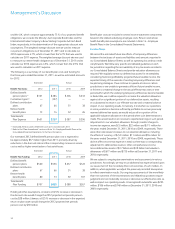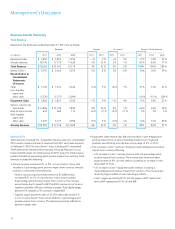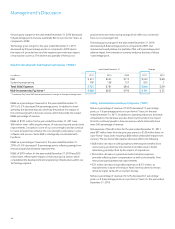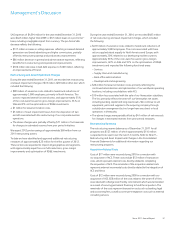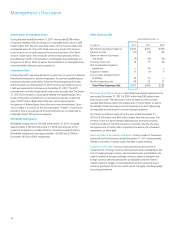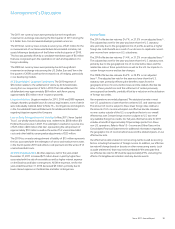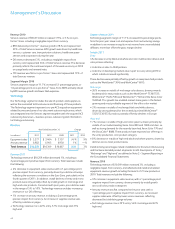Xerox 2011 Annual Report Download - page 35
Download and view the complete annual report
Please find page 35 of the 2011 Xerox annual report below. You can navigate through the pages in the report by either clicking on the pages listed below, or by using the keyword search tool below to find specific information within the annual report.Management’s Discussion
33Xerox 2011 Annual Report
The qualitative assessment of goodwill impairment requires significant
judgment. This assessment involves the consideration and evaluation
of various factors, including macroeconomic and general economic
conditions; entity-specific events such as industry and market conditions
as well as reporting unit-level financial performance; and other events
affecting a reporting unit, such as an expectation that a reporting unit will
be sold or reorganized.
After consideration of the margins from our 2010 quantitative
impairment test, our 2011 qualitative assessment centered on the
evaluation of the key factors from those noted above and whether there
had been any significant adverse changes since the 2010 quantitative
test. The assessment involved a review of internal and external sources
of information necessary to monitor the relevant factors for each
reporting unit, including a review of analyst reports as well as credit
rating information.
We believe that our expected long-term projections with respect to
revenue, operating profit and cash flows continue to be achievable based
on consideration of the following:
•Services–Services revenue grew in 2011, signings for new contracts
increased 14%, and our services pipeline increased 5% over the prior
year. Accordingly, we believe that we are well positioned for continued
future growth in each of our services reporting units consistent with
our long-term projections. As such, we continue to invest in growing
our DO, BPO and ITO service offerings to commercial and government
customers, both domestically and internationally.
•Technology– In 2011, we continued to hold our number-one
equipment revenue market share position and we also grew market
share. We also launched 27 new products, reflecting the continued
demand for our equipment. In addition, we continue to expand our
distribution capabilities to serve more small and midsize businesses.
•Costcontainment–We continue to offset pricing pressures and
increased supply chain costs with cost savings from restructuring and
productivity improvements.
•Capital– We remain an investment-grade company and have ready
access to the capital markets, including a commercial paper program.
Based on the above, in 2011, after completing our annual qualitative
reviews for each of our reporting units, we concluded that it was not more
likely than not that the carrying value of any of our reporting units exceeds
its fair value. Accordingly, we concluded that further quantitative analysis
and testing was not required, and no goodwill impairment charge was
required during the fourth quarter 2011.
Refer to Note 8 – Goodwill and Intangible Assets, Net in the Consolidated
Financial Statements for additional information regarding goodwill by
operating segment.
We file income tax returns in the U.S. federal jurisdiction and in various
foreign jurisdictions. In the U.S., with the exception of ACS, we are no
longer subject to U.S. federal income tax examinations for years before
2007. ACS is no longer subject to such examination for years before 2004.
With respect to our major foreign jurisdictions, we are no longer subject to
tax examinations by tax authorities for years before 2000.
Refer to Note 15 – Income and Other Taxes for additional information
regarding deferred income taxes and unrecognized tax benefits.
Business Combinations and Goodwill
The application of the purchase method of accounting for business
combinations requires the use of significant estimates and assumptions
in the determination of the fair value of assets acquired and liabilities
assumed in order to properly allocate purchase price consideration
between assets that are depreciated and amortized from goodwill. Our
estimates of the fair values of assets and liabilities acquired are based
upon assumptions believed to be reasonable and, when appropriate,
include assistance from independent third-party appraisal firms.
As a result of our acquisition of ACS, as well as other acquisitions including
GIS, we have a significant amount of goodwill. Goodwill is not amortized
but rather is tested for impairment annually or more frequently if an event
or circumstance indicates that an impairment may have been incurred.
Impairment testing for goodwill is done at the reporting unit level. A
reporting unit is an operating segment or one level below an operating
segment (also known as a component). A component of an operating
segment is a reporting unit if the component constitutes a business
for which discrete financial information is available, and segment
management regularly reviews the operating results of that component.
In the fourth quarter of 2011, we early-adopted ASU No. 2011-08,
Intangibles – Goodwill and Other (Topic 350) – Testing Goodwill for
Impairment, which allows an entity to use a qualitative approach to test
goodwill for impairment. As a result, in performing our annual impairment
test, we first perform a qualitative assessment to determine whether it
is more likely than not that the fair value of a reporting unit is less than
its carrying value, including goodwill. If it is concluded that this is the
case for one or more reporting units, we perform a detailed quantitative
assessment. Our annual impairment test of goodwill is performed in the
fourth quarter of each year.
We performed a quantitative goodwill impairment test in 2010. The
estimated fair values of our reporting units for that test were based on
discounted cash flow models derived from internal earnings forecasts and
assumptions. The assumptions and estimates used in those valuations
considered the current economic environment. Based on these valuations,
the fair values of our reporting units exceeded their carrying values by
more than adequate margins. The lowest margins were in two of the
three reporting units comprising our Services segment. However, these
two reporting units were the direct result of our acquisition of ACS and,
therefore, the lower margins were considered reasonable due, in large part,
to the recent nature of the acquisition.


